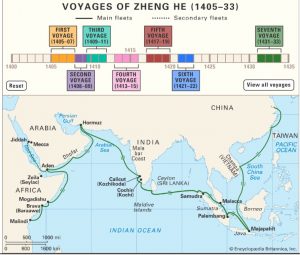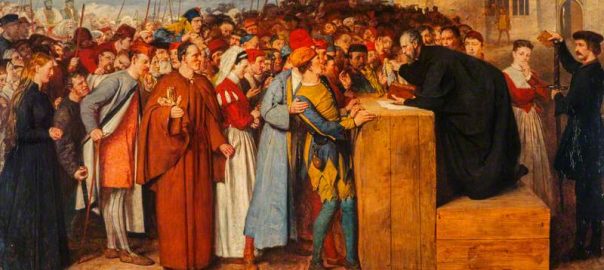Here were the main developments of world-historical impact, in 1559 CE:
- England’s Queen Elizabeth I got crowned and immediately enacted two laws central to the Protestant supremacy there. These were the Act of Uniformity, which laid down the order of service in the Church of England and forced all subjects to go to church once a week. The second was the Oath of Supremacy, which had earlier been introduced by Henry VIII but had lapsed (obviously) under the Catholic Queen Mary. The Oath of Supremacy required any person taking public or church office in England to swear allegiance to the monarch as Supreme Governor of the Church of England. Failure to do so was treated as treasonable. The Oath was later extended to include Members of Parliament and people studying at universities. Those prohibitions, which were not lifted till the 19th century, forced English people who were not C of E to go into trade, commerce, shipping, finance, etc, instead.
- Scotland, until then fairly strongly Catholic, saw an outburst of Calvinist activity after John Knox returned there from the Calvinist stronghold of Geneva and started stirring up the mobs. (The 19th century painting above shows Knox, extreme right, backing up fellow-Calvinist George Wishart as he preaches.)
- In general, sectarian differences continued to roil much of Europe. This did not, however, prevent the rulers of emerging “nation”-states there from concluding political agreements. In April 1559, two peace treaties were signed at Cateau-Cambrésis which brought to an end to what was called the “Italian War”– though Italy was just the battleground for the antagonists, who were Spain, France, and England. That “Italian War” had continued since 1551, and many of the land and sea battles I’ve noted here previously, including the Spanish-Ottoman sea battles in the Mediterranean in those years, were part of it.
- In August, what’s described as “a Spanish missionary colony” of 1,500 men arrived at Pensacola Bay, having traveled there from Vera Cruz (in today’s Mexico) on 13 ships. Led by conquistador Tristán de Luna y Arellano, they were founding the oldest European settlement on the mainland of today’s United States, called Santa Maria de Ochuse. But five weeks after they made landfall the expedition was struck by a hurricane that sunk five of the ships– on which they had foolishly left most of their supplies– and killed around 500 settlers. The survivors relocated. But they suffered famine, continuing attacks, and internal strife, and finally abandoned their settlement project in 1561.
- During 1559, a French diplomat called Jean Nicot brought some tobacco back to Paris after he’d been on a mission to Portugal. He described the plant’s medicinal qualities to the French court, where it apparently found favor; and he became eponymous. Cultivation of tobacco– like that of sugar– would become a bedrock of future European-origined settler-colonial projects in the Americas.
- And over in China, while the Jiajing Emperor doubtless continued his shenanigans, a rising military leader called Qi Jiguang faced (and aced) a major early test of new methods he’d introduced for training and equipping the imperial soldiery. Since 1555 Qi had been in charge of Zhejiang’s defense force against the wokou pirates, who were described as having included Japanese, Portuguese, and Southeast Asians, but “mostly Chinese.” In preparation for launching his big showdown with the pirates, Qi focused on drilling his soldiers. “He also oversaw the construction of 44 naval vessels of various sizes to be used against pirates at sea. The first trial for Qi’s new army came in 1559. After a month-long battle with wokou pirates in Taizhou Prefecture, the pirates suffered over 5,000 casualties, while Qi’s army established a name for itself among both the people of Zhejiang and its enemies.”
To be frank, one of the reasons I’m so interested in the whole wokou pirate phenomenon is because it seems to me to be a longlasting aftermath of the decision an earlier Ming Emperor had apparently taken, back in 1435 CE, to abruptly end a maritime exploration project that until then had been wide-ranging, well-funded, and stunningly successful. These were the explorations undertaken in extremely large and capable ships, all across the Indian Ocean including to the coast of East Africa, under the leadership of Admiral Zheng He, acting under the direction of the Yongle Emperor.
 The Encyclopedia Britannica page on Zheng He has a fascinating interactive graphic through which you can chart the seven major voyages he led between 1405 and 1433.
The Encyclopedia Britannica page on Zheng He has a fascinating interactive graphic through which you can chart the seven major voyages he led between 1405 and 1433.
Zheng He had a truly fascinating personal biography– from a Hui (Chinese Muslim) family, descended from Mongols; captured when the Mings took over, castrated, impressed into imperial service, etc… But what really interests me, in addition to Zheng He’s navigational record, is the decision the Yongle Emperor’s successor, the Hongxi Emperor, apparently took to end the idea of having any navy at all. Clearly, I need to read up a lot more on this. But imagine how different world history might have been if the Hongxi Emperor had not taken that decision.
Also, clearly, that whole process of Portuguese naval insertion into South-east Asia and the various other parts of the Indian Ocean they traversed would have been very different had the Ming Navy still had a presence in those waters…
